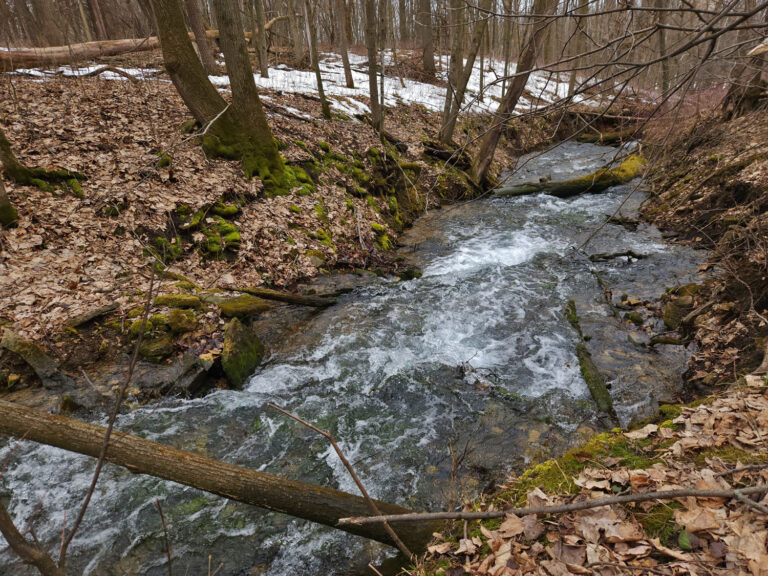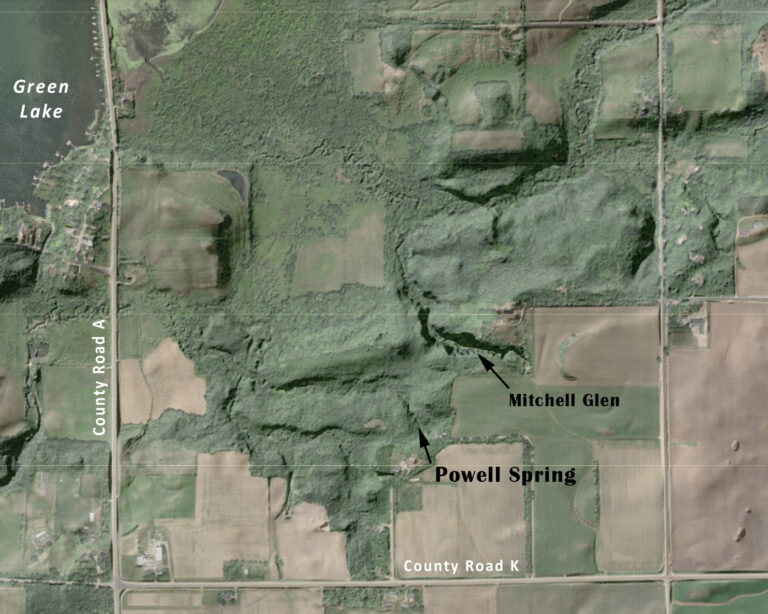The Natural History of Powell Spring
Those who have had the pleasure of viewing the impressive flow of Powell Spring as it comes pouring directly from the limestone bedrock are aware that they are seeing something truly rare and special. We cannot see or fully understand how the underground tributaries of groundwater have converged to create this impressive spring, but certainly it must have to do with the way the limestone has become fractured – perhaps just above a less-permeable layer that keeps the water from sinking deeper.
We do not know how long this large spring has been there, but at a bare minimum it’s been documented for at least 200 years, as recorded in written history. More than likely, however, it has been there for thousands of years. The limestone it emerges from is more properly known as Platteville-Galena dolomite, which was formed over 400 million years ago during the Ordovician Period.
We know that flowing springs have always been an important source of clean water for human civilizations, and certainly this one was no exception. Historical accounts mention the presence of Native American villages right around Powell Spring, certainly due to the water resources. Several trails – small and large – passed very close to this spring, including the Grand Butte des Morts trail, which linked Green Bay, Oshkosh and Portage.
The presence of the spring and all the associated human dwellings certainly made this a good location for the building of a log cabin trading post by James Powell in the 1830’s, and he was the person for whom the spring came to be named.
Early European settlers recounted the extensive native prairies that existed on the fairly flat land to the south of Powell Spring, including the presence of bison herds. The prairie vegetation was also documented by John Mullett, the first land surveyor, who surveyed the region in the mid-1830s. Periodic prairie fires burned across this open landscape – whether caused by lightning or intentionally set by the Native Americans who lived there. They had learned that fire could stimulate plant growth and increase the quantity of wildlife that lived on the prairies.
More protected from many of the prairie fires, the hills and ravines around and immediately north of Powell Spring were more forested, with most of the trees consisting of oaks (White, Black and Bur), hickory, ash, elm and maple. Historical accounts mention the annual tapping of the maple trees to collect sap for the making of syrup.
Nearby Mitchell Glen and the wooded ravines around Powell Spring likely harbored carpets of spring-blooming wildflowers (some of which are still present), and numerous other plants throughout the growing seasons. Mammals and birds were certainly in abundance during those pre-historical times, although many still live and breed at the site or visit during migration periods. Common birds at Powell Spring include woodpeckers, nuthatches, chickadees, cardinals, jays, crows and others.
The cold, oxygenated water that flows from the spring produces Powell Creek, which meanders downstream about a half mile until it merges with White Creek, which winds another mile or so (passing under Hwy. A) until it empties into Green Lake at its southeast corner. The spring flows nearly continuously year-round, but fluctuates somewhat during wet or dry periods. During times of snowmelt or spring rain it often reaches its maximum flow, and on rare occasions it may actually stop flowing for a time until the groundwater is recharged by additional precipitation.
Green Lake Conservancy is proud to have stewardship over this fragile ecological resource. The Conservancy feels it is vitally important to protect in perpetuity Powell Spring, Powell and White Creek, and ultimately Green Lake from both natural and human-made disturbances that would compromise the quality of its water and its flora and fauna.




